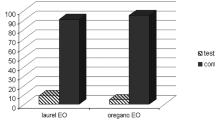Abstract
Two extracts from neem (Azadirachta indica A. Juss. (Meliaceae)) seeds, azadirachtin and oil, and a mixture of neem oil and abamectin, were tested on second-instar nymphs of the rice bugLeptocorisa chinensis (Dallas) (Hemiptera: Alydidae). To clarify the effect of spraying coverage on bioefficacy of test materials, experiments were conducted under choice and no-choice conditions in field cages. In a choice test, treatment with the mixture of neem oil and abamectin was most effective in reducing the survival ofL. chinensis, followed by azadirachtin at 60 ppm, 30 ppm and 3% neem oil, whereas all treatments except neem oil caused 100% mortality within 3 weeks in a no-choice test. When second-instar nymphs had choices of treated and untreated plants within a treatment, no differences in yield and sum of dead and stained grains were found between those two choices, indicating that nymphs neither caused significant reduction in yield nor reduced the quality of untreated plants. Regardless of treatment, the difference in overall yield between treated and untreated plants under choice conditions was not statistically significant (P>0.05). Our results indicate that neem-based formulations, used alone or in combination with abamectin, have the potential to be integrated into the existing programs to control the rice bug.
Similar content being viewed by others
References
Isman, B.M. (2004) Factors limiting commercial success of neem insecticides in North America and Western Europe.in: Koul, O. and Wahab, S. [Eds.] Neem: Today and in the New Millennium. Kluwer Academic Publishers, Dordrecht, the Netherlands. pp.33–41.
Jayaraj, S., Bharathi, M. and Sundara Barbu, P.C. (1993) Integrated Pest Management.in: Randhawa, N.S. and Parmar, B.S. [Eds.] Neem Research and Development, Society of Pesticide Science, India. New Age International (P) Ltd. Publishers, New Delhi, India. pp. 154–167.
Koul, O. (2004) Neem: A global perspective.In: Koul, O. and Wahab, S. [Eds.] Neem: Today and in the New Millennium. Kluwer Academic Publishers, Dordrecht, the Netherlands. pp.1–19.
Koul, O. and Dhaliwal, G.S. (2002) Microbial Biopesticides. Taylor and Francis, London, UK.
Ma, D.L. and Zalucki, M.P. (2002) Impact of neem oil sprays onHelicoverpa spp. oviposition and predators in cotton.in: Beattie, G.A.C., Watson, D.M., Stevens, M.L., Rae, D.J. and Spooner-Hart, R.N. [Eds.] Spray Oils beyond 2000 — Sustainable Pest and Disease Management. University of Western Sydney, Sydney, Australia. pp. 451–456.
Prakash, A. and Rao, J. [Eds.] (1997) Botanical Pesticides in Agriculture. CRC Press, Boca Raton, FL, USA.
SAS Institute (2000) JMP version 4.0, SAS Institute Inc., Cary, NC, USA.
Schmutterer, H. [Ed.] (1995) The Neem Tree — Source of Unique Natural Products for Integrated Pest Management, Medicine, Industry and Other Purposes. VCH Verlagsgesellschaft, Weinheim, Germany.
Schmutterer, H. and Singh, R.P. (2002) List of insect pests susceptible to neem products.in: Schmutterer, H. [Ed.] The Neem TreeAzadirachta indica A. Juss. and other Meliaceous Plants. 2nd ed. Neem Foundation, Mumbai, India. pp. 411–456.
Singh, R.P. (1993) Bioactivity against insect pests.in: Randhawa, N.S. and Parmar, B.S. [Eds.] Neem, Society of Pesticide Science, India. New Age International (P) Ltd. Publishers, New Delhi, India. pp. 146–159.
Sutherland, J.P., Baharally, V. and Permaul, D. (2002) Use of the botanical insecticide, neem to control the small rice stinkbugOebalus poecilus (Dallas, 1851) (Hemiptera: Pentatomidae) in Guyana.Entomotropica 17:97–101.
Author information
Authors and Affiliations
Corresponding author
Additional information
http://www.phytoparasitica.org posting Aug. 28, 2005.
Rights and permissions
About this article
Cite this article
Ma, DL., Suzuki, Y., Takeuchi, H. et al. Effects of neem (Azadirachta indica) extracts onLeptocorisa chinensis under choice and no-choice conditions. Phytoparasitica 33, 506–514 (2005). https://doi.org/10.1007/BF02981400
Received:
Accepted:
Issue Date:
DOI: https://doi.org/10.1007/BF02981400




